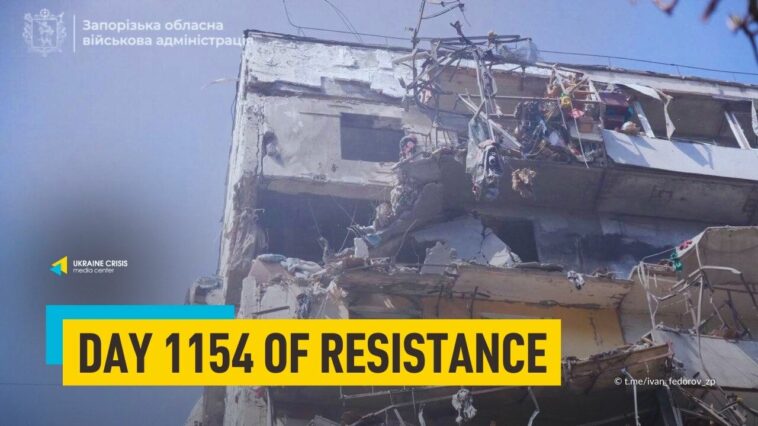Russia launches drone attacks on Odesa and Kharkiv, drops glide bombs on Zaporizhzhia, injuring dozens. Russia uses Putin’s Easter truce to improve its tactical positions in the Lyman direction. Putin reiterates rejection of full ceasefire that Zelenskyi and U.S. have offered, ISW explains his statements.
Russia launches drone attacks on Odesa, Kharkiv, drops glide bombs on Zaporizhzhia, injuring dozens
Russia launched a major drone attack on Odesa late on Monday. The drones targeted apartment buildings in a densely populated neighborhood, city mayor Hennadiy Trukhanov said. Three people were injured in the attack. Head of the Odesa regional military administration, Oleh Kiper, said the strike damaged dwellings, civilian infrastructure, an educational institution and vehicles.
A Russian day-time drone attack on Kharkiv on Tuesday caused damage to four districts and injured 10 people. There were at least 12 episodes when drones hit targets, city mayor Ihor Terekhov said. A car caught fire after one of the drones struck road pavement nearby. Three people were injured in the episode.
Russia struck Zaporizhzhia with two glide bombs on Tuesday, killing a woman and injuring at least 38 other people, including four children, head of the regional military administration, Ivan Fedorov, said. One of the bombs struck a critical infrastructure site, and the other hit a densely populated area of the city. Boys ages 3, 4, 14 and 16 were taken to hospital in serious condition, Fedorov said.
Russia uses Putin’s Easter truce to improve tactical positions in Lyman direction
Russian forces in the Lyman direction, in Donetsk region, did not comply with a one-day Easter ceasefire that was announced by Putin on Saturday. After it expired on Monday midnight, they launched a major infantry assault, spokesperson for the 66th “Prince Mstyslav Khorobryi” Separate Mechanized Brigade, Lieutenant Anastasiya Blyshchyk told Suspilne on Tuesday.
“The so-called ‘ceasefire’ caused us more harm, because just a few hours after Putin announced the ‘truce’, our positions came under heavy artillery fire. The enemy also used attack drones [against us]. Their infantry began to storm one of our mechanized battalions,” Blyshchyk said.
Russia used the time to improve its tactical positions, she added.
“We saw them move infantry and weapons, including rocket-propelled grenade launchers and machine guns, closer to the front line. Our aerial reconnaissance units recorded how more than 120 Russian troops had dispersed in the windbreaks, forested areas, ruined buildings and dugouts during the so-called Easter truce. And as soon as the carriage turned into a pumpkin — that is to say, when the so-called ‘Easter truce’ expired, the Russians launched a major infantry assault,” Blyshchyk said.
Russia launched more than 10 attacks at Ukrainian positions in the Lyman direction on Monday, the General Staff of the Armed Forces of Ukraine said. The area, which is within the responsibility of the 66th brigade, is one of Russia’s priority sectors of the front line, Blyshchyk said.
On Saturday, Russian leader Vladimir Putin announced a unilateral Easter truce in Ukraine until midnight on Monday. “We assume that the Ukrainian side will follow our example,” he said.
Russia committed 2,935 violations of the truce, Ukrainian President Volodymyr Zelenskyi said after hearing a report from Commander-in-Chief of the Armed Forces of Ukraine, General Oleksandr Syrskyi.
Zelenskyi made an offer to extend the truce by 30 days, but Putin did not order the ceasefire to continue. He said Russia would consider the Ukrainian ceasefire proposal. “We will analyze everything and take the corresponding decisions,” he told state reporters in Moscow.
Putin reiterates rejection of full ceasefire that Zelenskyi and U.S. have offered, ISW explains his statements
Putin’s continued rejection of the US-Ukrainian March 2025 proposed general ceasefire and the Kremlin’s refusal to commit to any time frame to end the war highlight Putin’s disinterest in ending the war via peace negotiations in the near term, the Institute for the Study of War (ISW) said in a report on April 21. The paragraphs below are quoted from the report.
Putin’s continued rejection of US and Ukrainian ceasefire proposals runs counter to Trump’s stated approach of first establishing a ceasefire and then negotiating a broader peace agreement and to Trump’s goal of achieving a lasting peace in Ukraine.
Putin announced the end of the Easter truce on April 21 and rejected Zelensky’s proposed temporary moratorium on long-range strikes against civilian infrastructure while speaking to journalists, stating that Russia would need to “sort out” the proposed civilian infrastructure strikes moratorium. Putin attempted to soften his rejection of Zelensky’s ceasefire proposal by claiming that Russia and other unspecified actors need to study strikes against civilian targets where military personnel are operating and “make appropriate decisions.” Putin did not suggest the possibility of creating independent monitoring mechanisms to determine the legitimacy of such strikes, and Russian officials have previously expressed disinterest in Western-led monitoring mechanisms as a condition of future ceasefires in Ukraine.
Putin also attempted to justify Russia’s recent missile strikes against Ukrainian civilian infrastructure and to obfuscate his ongoing rejection of US and Ukrainian ceasefire proposals. Putin acknowledged that Russian forces recently struck civilian infrastructure in Sumy City — likely referring to the April 13 Russian missile strike against Sumy City — but suggested that the reported presence of Ukrainian military personnel in Sumy City constituted a legitimate military target. Putin claimed that Russian forces also targeted Ukrainian military personnel during a recent Russian strike against Odesa City.
Putin rejected the full ceasefire proposal on April 21, claiming that Ukraine was attempting to “seize the initiative and talk about expan[ding]” the ceasefire, and alleging that Russia would need to “carefully evaluate everything.”
US President Donald Trump expressed hope on April 20 that Russia and Ukraine would make a deal this week, possibly referring to a general ceasefire agreement that would precede future peace negotiations. Kremlin Spokesperson Dmitry Peskov appeared to respond to Trump’s statement by stating that the Kremlin is not ready to discuss a time frame to end the war.

